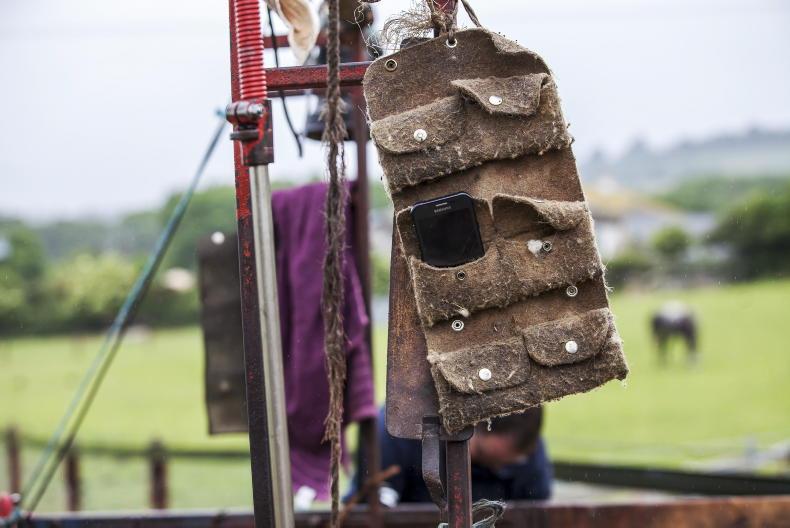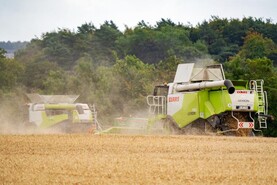Sheep farmers have one of the oldest average age profiles in the agricultural sector.
This group is also the most likely to avail of contractors when shearing.
Thankfully, an increasing number of farmers in the older age bracket of farmers have availed in recent months of the vaccine rollout.
Farmers and shearing contractors have a duty of care to protect themselves and each other
While farmers who have been vaccinated have, on average, a better defence against serious illness, the risk of the spread of coronavirus remains at a high level.
Therefore, it is vital that precautions are not overlooked. Farmers and shearing contractors have a duty of care to protect themselves and each other.
The National Association of Agricultural Contractors (NAAC) in the UK developed an extensive guidance document for the shearing industry and a useful checklist that is recommended to be followed.
The checklist can be found by scanning the QR code (right) with your smartphone and it is also endorsed by the Irish Sheep Shearers Association.
The top 10 recommendations from the document are outlined below.
1
Clear plan: all contact between the farmer and shearing contractor prior to shearing taking place should clearly establish and set out a plan for how work can be completed abiding by social distancing.
2
Adequate preparation: farmers should ensure that practices such as splitting ewes and lambs, fasting sheep before shearing, dagging dirty tail-ends, etc, are all completed in advance of shearing so that sheep are in optimum condition for shearing, delays are avoided and any interaction between farmers and shearers is kept to a minimum. The checklist recommends shearing sheep outdoors or in a building with a good airflow.
3
Health check: anyone feeling unwell or presenting with any COVID-19 symptoms must not be present at shearing. Social distancing of 2m should be maintained at all times and where this is not possible for any reason, then HSE/NHS guidelines should be followed with regards working in close confines.
4
Washing facilities: hand-washing facilities or hand sanitiser should be available and hand-washing guidelines followed. Agreeing at the outset what is expected of each party will avoid confusion and unnecessary risks while shearing.

Sheep should be sorted with help on hand to cut down on the need for any unnecessary interaction between shearing contractors and farmers.
5
No bystanders: shearing should be handled as the essential task that it is and not viewed as an attraction that brings visitors or onlookers around.
6
Handling of equipment: farmers should be responsible for their own equipment and handling of penning, etc, while shearing contractors must be responsible for putting up their own equipment and cleaning and disinfecting after use.
Separate working areas should be maintained where at all possible. If this is not possible, then shared areas such be cleaned/disinfected thoroughly.

Wool can be collected in a safe manner by using a brush with a long handle for example or the shearer can move it from the shearing stand to facilitate safe packing by whoever is handling the wool.
7
Wool packing: social distancing when packing wool can still be achieved with adequate planning. For example, the shearer can kick the wool off the board or the person handling the wool can use a brush to collect wool without breaking social distancing.
8
Disinfecting equipment/clothing: The document recommends disinfecting all equipment between farms and also advises contractors to bring a change of clothes/moccasins.

Equipment should be handled by its owner and cleaned and disinfected between farms.
9
Travel arrangements: Where shearers are working in teams and are not part of a pod, then they should travel separately to jobs. If this is not possible, wear a mask and keep the vehicle well-ventilated.
10
Work together to overcome any issues: shearers are likely to be under more pressure this season, while everyone involved will be more concerned about the risks faced.
Sheep farmers have one of the oldest average age profiles in the agricultural sector.
This group is also the most likely to avail of contractors when shearing.
Thankfully, an increasing number of farmers in the older age bracket of farmers have availed in recent months of the vaccine rollout.
Farmers and shearing contractors have a duty of care to protect themselves and each other
While farmers who have been vaccinated have, on average, a better defence against serious illness, the risk of the spread of coronavirus remains at a high level.
Therefore, it is vital that precautions are not overlooked. Farmers and shearing contractors have a duty of care to protect themselves and each other.
The National Association of Agricultural Contractors (NAAC) in the UK developed an extensive guidance document for the shearing industry and a useful checklist that is recommended to be followed.
The checklist can be found by scanning the QR code (right) with your smartphone and it is also endorsed by the Irish Sheep Shearers Association.
The top 10 recommendations from the document are outlined below.
1
Clear plan: all contact between the farmer and shearing contractor prior to shearing taking place should clearly establish and set out a plan for how work can be completed abiding by social distancing.
2
Adequate preparation: farmers should ensure that practices such as splitting ewes and lambs, fasting sheep before shearing, dagging dirty tail-ends, etc, are all completed in advance of shearing so that sheep are in optimum condition for shearing, delays are avoided and any interaction between farmers and shearers is kept to a minimum. The checklist recommends shearing sheep outdoors or in a building with a good airflow.
3
Health check: anyone feeling unwell or presenting with any COVID-19 symptoms must not be present at shearing. Social distancing of 2m should be maintained at all times and where this is not possible for any reason, then HSE/NHS guidelines should be followed with regards working in close confines.
4
Washing facilities: hand-washing facilities or hand sanitiser should be available and hand-washing guidelines followed. Agreeing at the outset what is expected of each party will avoid confusion and unnecessary risks while shearing.

Sheep should be sorted with help on hand to cut down on the need for any unnecessary interaction between shearing contractors and farmers.
5
No bystanders: shearing should be handled as the essential task that it is and not viewed as an attraction that brings visitors or onlookers around.
6
Handling of equipment: farmers should be responsible for their own equipment and handling of penning, etc, while shearing contractors must be responsible for putting up their own equipment and cleaning and disinfecting after use.
Separate working areas should be maintained where at all possible. If this is not possible, then shared areas such be cleaned/disinfected thoroughly.

Wool can be collected in a safe manner by using a brush with a long handle for example or the shearer can move it from the shearing stand to facilitate safe packing by whoever is handling the wool.
7
Wool packing: social distancing when packing wool can still be achieved with adequate planning. For example, the shearer can kick the wool off the board or the person handling the wool can use a brush to collect wool without breaking social distancing.
8
Disinfecting equipment/clothing: The document recommends disinfecting all equipment between farms and also advises contractors to bring a change of clothes/moccasins.

Equipment should be handled by its owner and cleaned and disinfected between farms.
9
Travel arrangements: Where shearers are working in teams and are not part of a pod, then they should travel separately to jobs. If this is not possible, wear a mask and keep the vehicle well-ventilated.
10
Work together to overcome any issues: shearers are likely to be under more pressure this season, while everyone involved will be more concerned about the risks faced.









 This is a subscriber-only article
This is a subscriber-only article











SHARING OPTIONS: